What paint to paint the walls in the apartment: the choice of composition, paint design
If renovation awaits you, but you don't want to glue the wallpaper, the question inevitably arises: how to cover the walls in the apartment instead of wallpaper. Leaving two: decorative plaster and painting. Experience is desirable to work with plaster, but painting the walls in an apartment can be done at a fairly high level and without experience. You need desire, time and accurate performance of operations. By the way, there is paint that imitates some plasters well, but costs less.
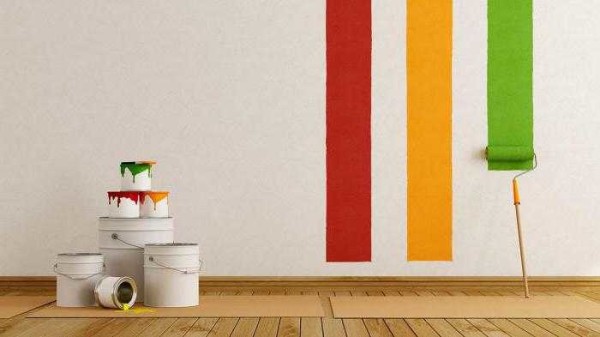
Painting walls in an apartment is an increasingly relevant way of decorating
The content of the article
Living room paints
The most important thing in choosing paints for this group of premises is their harmlessness. Also, high requirements are imposed on the decorativeness of coatings and resistance to sunlight. Such a characteristic as washing ability is not the most demanded, except that it may be necessary in a children's room. It is very good if the paints do not smell, or almost do not smell during application, and it is also desirable that they dry quickly.
Water based paints
More than others, water-based formulations meet these requirements. The binder component may be different in them, which is why some qualities change, but they have one thing in common: they are harmless to people, do not harm the surrounding space, dry quickly and have almost no odor.
Water-based
The most popular in this group are water-based paints. These are compositions based on polyvinyl acetate (more familiar to us as PVA). This paint is easy to apply, has good hiding power - usually two coats are enough to get an even color. After drying, a dense film is created on the surface, which allows water vapor to pass through, they also say that such a wall "breathes". It can be tinted very well - any color can have dozens of shades.
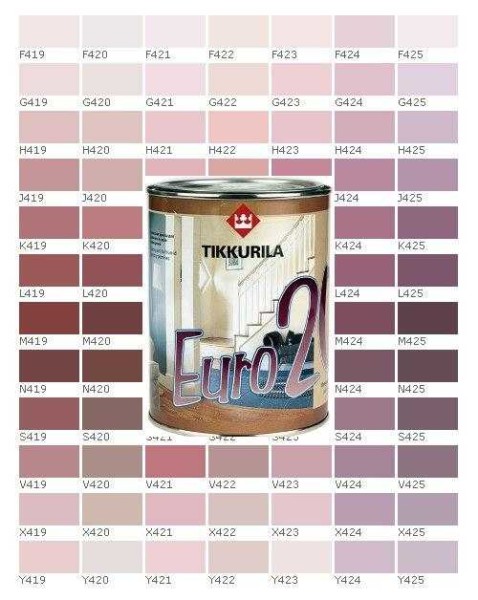
Water-based paint of the famous brand "Tikkurila" and tinting card in just one color
One of its main advantages is its low price. And this is perhaps the decisive factor that makes water emulsion the best sellers, even despite their rather serious shortcomings.
The first serious disadvantage is that it is not very resistant to mechanical or abrasive influences (it is easy to scratch it). The second - it does not hide the imperfections of the surface, it requires careful preparation. For the wall to look, it must be absolutely smooth. The third drawback is the fear of water. A wall covered with water-based emulsion can be wiped with a damp cloth several times, but not all shades. On some, the stripes will be clearly visible. But the walls can be tinted - leave a little "in reserve" to eliminate stains and scuffs that appear after a while in the most "loaded" areas.
Water-dispersive silicone
These paints are almost perfect. They are easy to apply, and they are able to tighten even quite decent cracks - up to 2 mm. The film remaining after drying does not fade, is not afraid of moisture, is heavily damaged (you can wash as much as you like). Painting the walls in an apartment with silicone paint allows you to get a very smooth surface even without perfect preparation and careful alignment.
After drying, the film is so smooth that even microparticles do not linger on it, dust does not accumulate. What is important - the paint is vapor-permeable, which makes it possible to use it in wet rooms. High resistance to UV light allows it to be used for outdoor decoration (its main application).
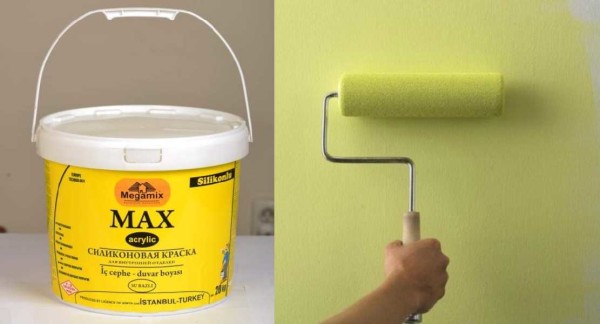
Water based silicone paint - excellent quality coating
In fact, it has only one drawback: the high price. This is the most expensive paint today (except for textured ones). This explains the fact that they are not very popular. But if you want to have a durable, beautiful wall covering in an apartment or house, choose a silicone paint. In any case, it can be used in the hallway and in the kitchen.
Acrylic water-dispersion
This type of paint is perhaps ideal: it is perfectly tinted, does not fade, it is well applied, even paints over cracks, although smaller in size - up to 0.7-1 mm. It has an average vapor permeability, the coating is difficult to damage, it can be washed even with detergents. She has no particular flaws. In some parameters (vapor permeability), it is slightly worse than a water emulsion, in some (hiding power) it is slightly inferior to silicone paints, but in general it gives a very good result.
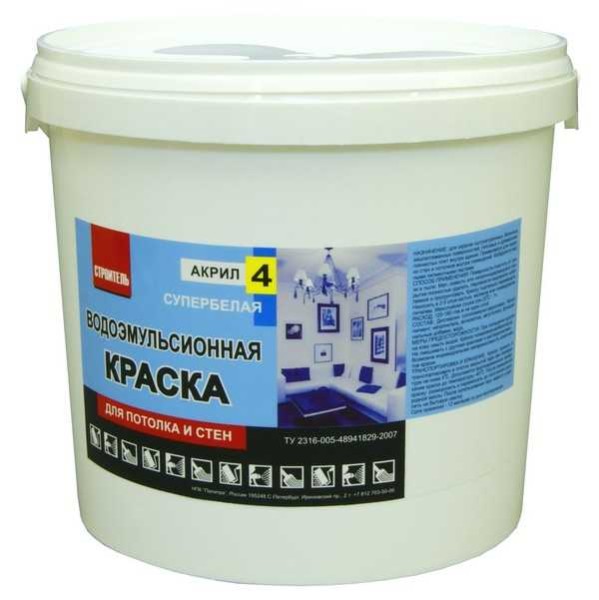
Acrylic paint does not fade, is not afraid of moisture
Painting the walls in an apartment with this paint will not be too expensive: the price is average. So if you take the price / quality combination, this is the best paint, both for walls and for the ceiling.
Decorative textured paints
This is a relatively new direction. Painting walls in an apartment with textured paints allows you to get not a smooth, evenly painted surface, but having a certain or chaotic relief. The basis of textured paints is an acrylic water dispersion with a pigment and various additives - sand of different fractions, mineral fibers and other similar substances that form a relief.
These paints differ in density, respectively, they can be applied with a spatula, brush or roller. Some types allow the use of a spray gun. The texture can vary depending on the type of application, and significantly. For example, in the photo below, you can see the result of applying the same paint with different tools - a brush, various rollers and a spatula. In the photo - decorative paint for walls and ceilings of the German company JOBI. It is called PUTZEFFEKTFARBE (PutzEffektFarbe).
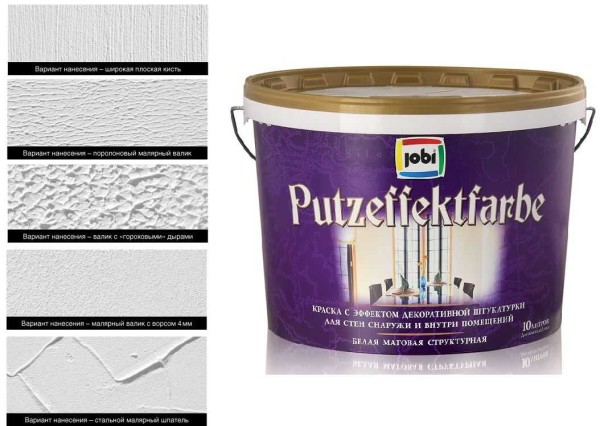
One of the options for textured paint
This composition is painted in any color from the palette, so there are a lot of options. Can be applied to drywall, concrete, Chipboard, Fiberboard, plastered surfaces. For best effect, a preliminary primer is desirable.
There are decorative paints with imitation of fabric, suede, pearlescent stains, aged surface and many others. The application is sometimes multi-layer - in three layers or more - using different tools. Typically, such compositions are accompanied by detailed instructions for application and work procedure, as well as recommendations for choosing a tool.
You will see several ways of applying decorative paint in the video.
You may be interested in reading about choosing wallpaper for the bedroom.
Paints for bathrooms, kitchens and corridors
For kitchens and corridors, the above decorative acrylic paints and water-based silicone paints are suitable. They have sufficient abrasion resistance and can be washed frequently. The use of paints with a pronounced relief in kitchens is not entirely justified - it will be difficult to keep the walls clean. But mother-of-pearl stains can make a small room visually more spacious, especially if the base color is light.
But there are several more moisture and temperature resistant paints that can be used in humid rooms - kitchens and bathrooms, but are undesirable in living rooms.
Alkyd compounds
Alkyd paints in their consistency are very similar to oil paints, but they have a significant difference both in the base (alkyd resins) and in operational characteristics. The surface painted by them tolerates high humidity, high temperatures, exposure to ultraviolet radiation well. It has an average vapor permeability, therefore it can be used in humid rooms. It works well on wood and metal surfaces. What else attracts in these paints is that painting the walls does not require significant investments - they are inexpensive. However, a well-prepared surface is required for a normal look. According to the type of surface created, alkyd paint can be glossy, matte, semi-matte.
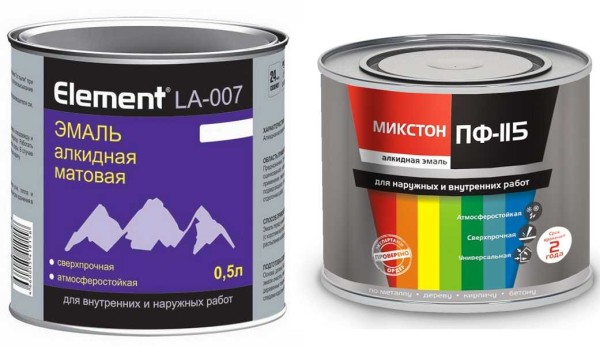
Examples of alkyd paints
There is only one serious drawback - they are diluted with organic solvents - white spirit, gasoline, turpentine. Therefore, when painting and drying, there is a persistent characteristic smell in the room. Also a minus - they eventually lose color brightness, a yellowish bloom appears. The option is inexpensive, but not the best in terms of durability. They are very good for painting radiators and heating pipes - they can be heat resistant - but for walls it is worth using a different composition.
Silicate based paints (liquid glass)
If we talk about the specific properties of a silicate coating, then this is a good choice for a bathroom: the chemical composition is such that fungus or mold never appears on the painted walls. If there is such a problem, this is one of the options for solving it. The coating is very strong and durable, and the vapor permeability is the highest among all existing paint and varnish compositions. Therefore, you can use these paints in the kitchen and in the bathroom.
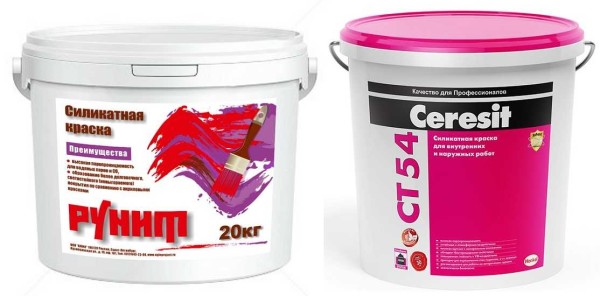
Silicate paint - prevents the development of fungi and mold
But there are significant downsides. First, until it dries, the composition is very unhealthy. You need to work with him in protective clothing and respiratory protection (good respirator). After drying, the film is absolutely harmless, but it is impossible to stay indoors before crystallization. Secondly, silicates are not compatible with other types of coatings. They do not lie on surfaces previously painted with any other paint. Likewise, no other surface will "lie" on the surface painted with silicate paint. In both cases, complete removal of the previous layer is required. Thirdly, the compositions are tinted only with mineral pigments, and this significantly reduces the number of colors and shades.
You may be interested in the topic "How to choose a kitchen apron for the work area"
Wall painting design
There are a lot of options for painting the walls, because there are no restrictions on the quantity. It is important to find the right matching color combination when painting the walls. The easiest way to do this is to select shades according to the tables that designers use. In them, in groups, shades are collected that can be used in one room, while the interior will be harmonious.
Now about the methods of combined wall painting. There are quite a few of them, they will look differently in the interior. Choose the one you like.
Horizontal division into two or three zones
This method is traditional. Usually the room is divided into two zones. At the bottom they paint in darker shades, at the top - lighter ones. The classic version - division into three parts in height - the lower third is painted with a dark shade, the upper two - lighter. But this is just a classic, in reality the dark paint can end in the middle or almost under the ceiling. Only with this technique you need to be more careful: it visually makes the ceilings lower. The exception is a light strip almost under the ceiling.
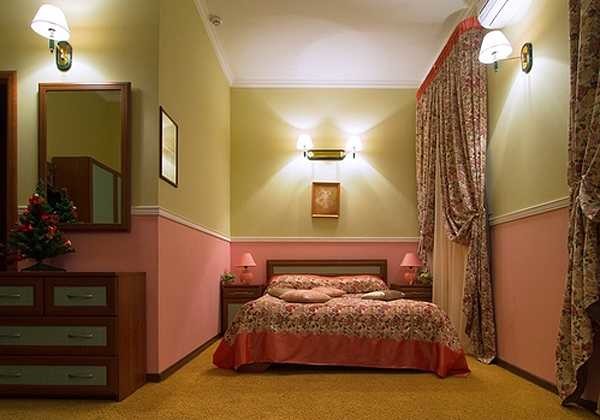
Painting a room in two colors: horizontal separation
The border of two colors, if the painting of the walls in the apartment is done independently, is rarely ideal. To decorate flaws, you can glue molding, some kind of even stripes.Another option - before applying the second shade along the border exactly, glue masking tape along the ruler. After painting, remove it, you get a perfect line (if you glued the tape exactly).
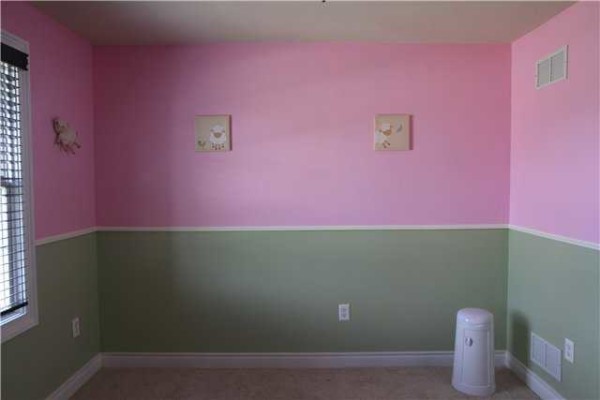
The molding can be left white - it can be combined with any colors, or it can be painted in one of the suitable colors
This technique can be used in rooms for any purpose, and the style can be any. Only with moldings - this is more of a classic, it is acceptable for the country style, for one of the ethnic styles. Just a clear border or a division decorated with a shiny stripe is already minimalism or high-tech.
Accentuating the wall
A fashionable trend in decorating rooms is highlighting a wall with color. There are two options here:
- a darker shade of the same color;
- another color from a compatible palette.
With well-chosen details in the interior, both methods look attractive. This is the easiest way to make your interior more memorable and vibrant.
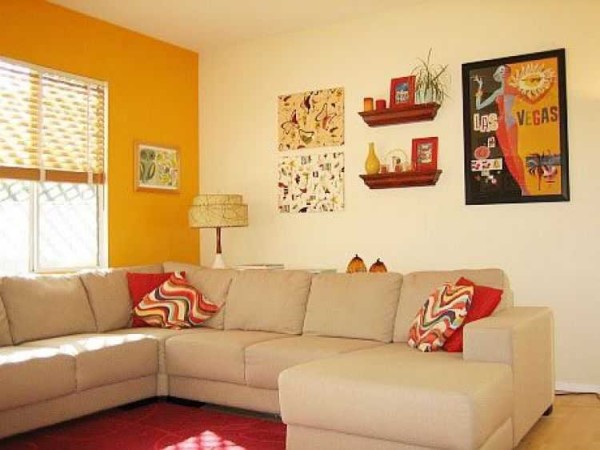
A bright color from the same palette is the easiest way to brighten up your interior.
Just keep in mind that in bedrooms, for example, it is better to use less harsh combinations - the atmosphere in such rooms should be softer. Sharp contrasts are good in living rooms, children's rooms. Children generally like bright combinations.
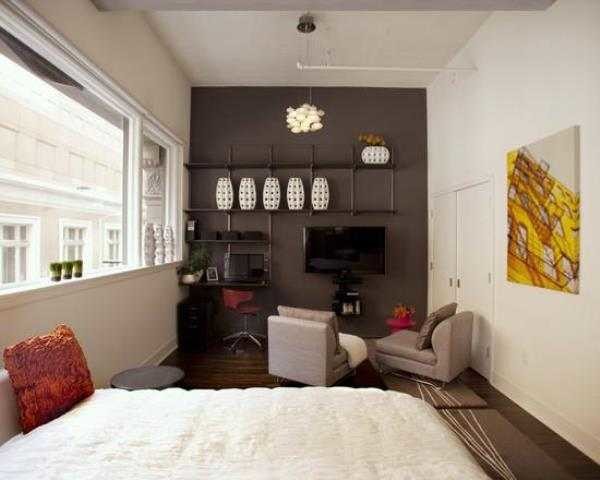
The range in the bedrooms is quieter
Horizontal stripe
This is a fairly wide band that runs approximately at eye level. Most often, this type of room coloring is resorted to if you need to pay attention to some decorative elements - paintings, for example.
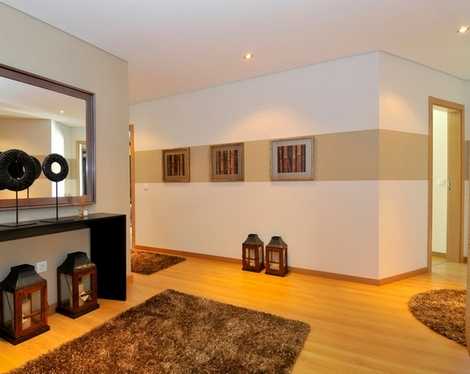
Wide horizontal stripe is another way to paint a room in two colors
This technique looks good in corridors - by lowering the height of the ceiling, it makes it seem wider. Another popular use is children's rooms: children's drawings look very good on a stand-out background.
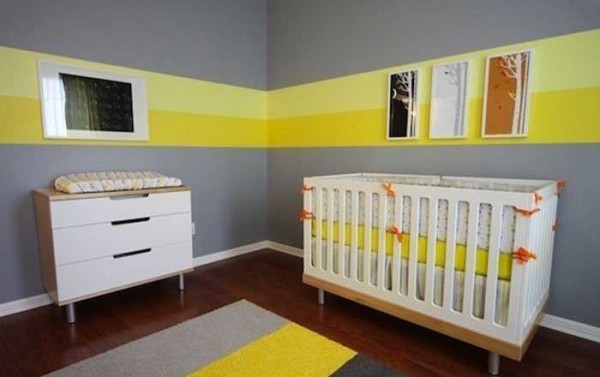
The stripe does not have to be solid - a light gradient is fine too.
Striped walls
An interesting trick, but you shouldn't use it for the whole room. So you can design one wall - one of the varieties of an accent wall - or just a part of it.
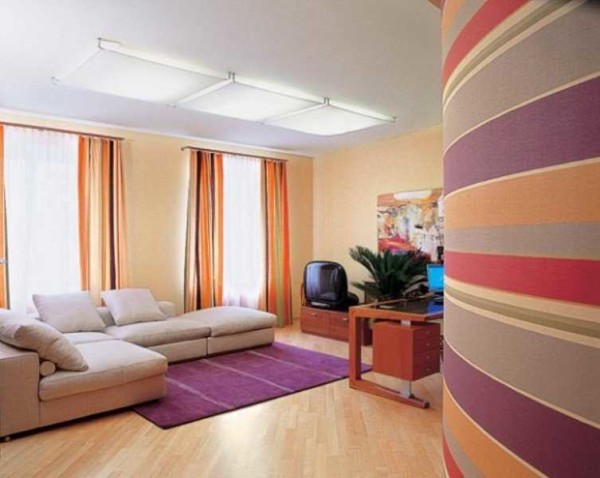
Horizontal stripes can be multi-colored. The main thing is that they are repeated in the interior.
An interesting effect is provided by a combination of stripes of the same color, but with a different texture - matte and glossy. Strictly speaking, these are not two colors, but they look exactly like this.
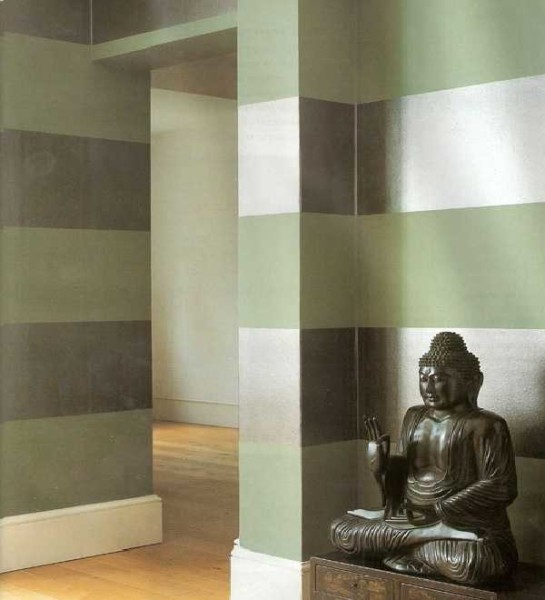
Combination of matte and glossy paint stripes
Highlighting some interior details
Often, some details are emphasized with a different color - brighter or more calm. For example, niches, frames, placement of an interesting shelf, etc.
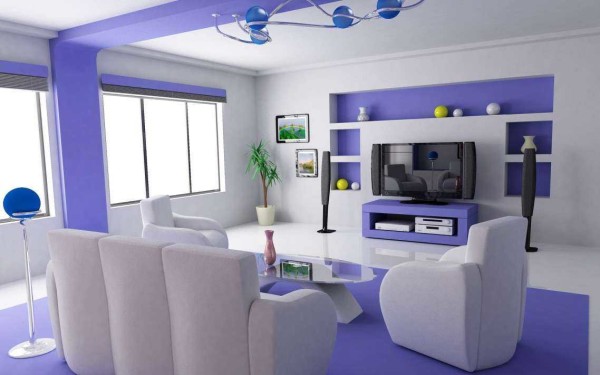
Selecting some elements is another way to combine painting a room
One of the options is to circle the wall with a strip of darker color along the contour, thus selecting all the corners. This method will help make a small room more spacious: it will appear both taller and wider.
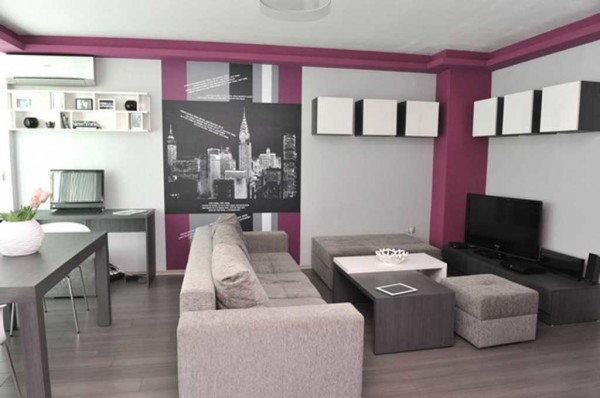
A way to visually enlarge a room
How to develop design of the kitchen-living room, read here.
How to paint the walls in an apartment with your own hands: video
Choosing a paint type is good, but you also need to know how to work with it. Each of the paints has its own characteristics of application and surface preparation. But in general, the following steps are almost always present:
- Removing the old coating, if any. The thoroughness of this step depends on the compatibility of the old topcoat and the new coat. If they are compatible, remove only loose or loose parts. If the coatings are not compatible, you will have to clean everything completely.
- Plastered walls. The technology is standard: they take a suitable composition and apply with a spatula, covering up cracks and irregularities.
- Surface grinding. Either sandpaper or a special mesh is used, fixed on a holder or a wooden block. In a circular motion, remove all unnecessary, leveling the walls.
- Dedusting the sanded surface. It is better to use a vacuum cleaner, but you can wipe everything with a dry cloth several times, but every time it is clean.
- Primer.The primer for each surface and paint must be selected separately. It is advisable to purchase it with paint. Priming performs two tasks: it improves the adhesion of paint to the surface (it will not flake off) and reduces paint consumption.
- Painting. Painting usually in several layers, applying the composition in different directions. if we talk about walls, then from top to bottom, and then - from right to left. Each layer is applied after the first has dried. The instructions usually indicate this time and it is desirable to withstand it.
That's all. The painting of the walls in the apartment is finished. But a verbal description cannot convey some of the features of working with paints or putties. Watch the video tutorial, some of the subtleties will become clearer. After viewing it, painting the walls with water-based paint with your own hands will not be a problem.
How to create the effect of decorative paint on the walls with simple means, see the video.

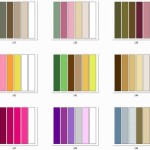
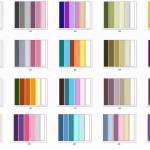
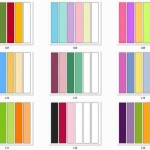
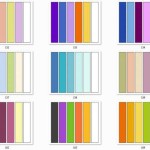
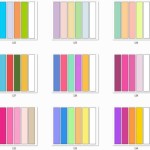
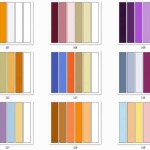
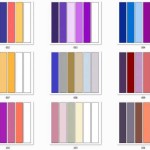
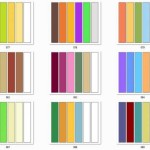
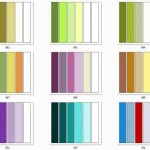
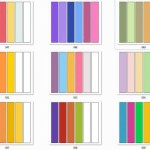
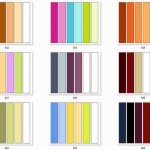
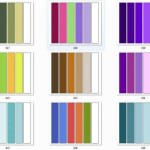
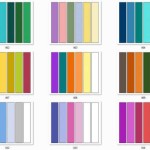

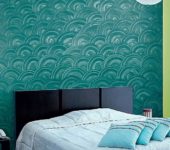
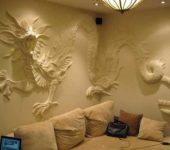
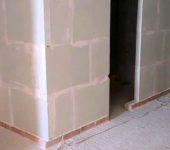
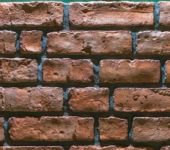





Thanks for the helpful and very clear article! We did home renovations and got some inspiration from you) now we have a contrasting wall in the color of wet asphalt in our bedroom)) Special thanks for the video instruction. The Marshall Paint Consumption Calculator is a godsend. After viewing, we clearly identified the brand of materials and took the entire line of Marsshall Export. And they never did. Repair quietly ... as far as possible =)
I painted the walls in the bedroom with Dulux paint. It is easily applied without splashes and drips, and most importantly, it does not smell at all. After painting, the color is just class!
And we treated everything with belinka. House outside and inside. No smell, easy to apply and dries quickly. By the way, I recommend treating wooden furniture with squirrel (there are different oils and impregnations in the assortment) so that it is better preserved and it looks completely different after processing!
I liked the article very much, meaningful, nothing superfluous. All clear. Thank you